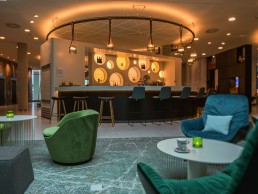
Hyatt Place, Germany
Making its debut in Frankfurt, Germany, Hyatt Place provide stylish comfort and convenience for business travellers, thanks to warm and welcoming interior design from JOI-Design.
JOI-Design has created the interiors for the newly opened Hyatt Place Frankfurt, the lifestyle brand’s first property in Germany. Balancing the calm of nature with high-tech efficiency, the studio as designed an ‘urban jungle’ concept that uses natural materials and palettes to create a connection between the city and nature. The result is a relaxing yet energising sanctuary from the adjacent Frankfurt airport.
The 312-room new build was conceived to provide stylish comfort and convenience for business travellers constantly on the move through the largest hub in Europe. Part of Gateway Gardens, a recently constructed commercial development located at the former Rhein-Main Airbase, the site is a hive of activity in the daytime, while during the early mornings and evenings, it grows quiet. Creating a warm, welcoming ambience was essential to ensure the silence felt relaxing rather than lonely and, with most guest staying only one night, offer a taste of Frankfurt’s culture. JOI-Design first became involved in this project, early 2015, when Feuring Visionary Hotel Development, a long-standing hotel developer embarked on the construction of the building.
The design firm’s brief was to create a contemporary and European take on the Hyatt Place brand and simply build the best hotel in the select service field in Gateway Gardens. Project leader and JOI-Design Partner, Heinrich Boehm, tells darc: “This project offered the best conditions to allow for a smooth workflow. All stakeholders operated on a highly professional basis, having excellent experience in the hotel business. As such, the implementation of our client’s wishes and needs happened quite quickly… The more challenging part of the brief was to identify and strengthen the core of the Hyatt Place brand, as it has been developed in the US… while at the same time, keeping the brand modern and exciting for the target group of business travellers in Europe. This was a joint effort by all players including the Hyatt design team in Dubai.
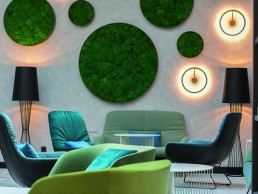
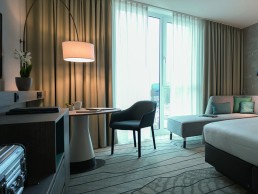
“As the work progressed, it turned out that the building part of the budget had been very well managhed and we were therefore able to slightly increase the FF&E budget and spend more on the public areas. This was really helpful, allowing us to increase the quality of the products and improve guest experience.”
JOI-Design found inspiration in the neighbouring parklands that emerged since the US Air Force planted trees at the base decades ago. Reflecting guests’ desire for wellness and natural connections, the greenery of the outdoors has become an appealing interior focus. Round, framed patches of moss hung on the lobby walls bring a sense of freshness and suggest the nearby woodland topography as seen from the air.
Open-structured room dividers in the public areas introduce degrees of intimacy while still allowing guests to feel connected with their surroundings. The first can be seen in the lobby, with ropes strung between full-height circular frames and a suspended track that projects light onto the ceiling. The lattice design has also been used as art behind the reception desk, both to reference the airport’s vast network of flights and to inject a creative energy that uplifts the relaxed, inviting vibe. The criss-cross pattern is additionally echoed in the illuminated circular ceiling structure above a double sided ‘island’, which fucntions on one half as a reception and on the other as a bar for the lounge. On the reception side, assorted green, grey and white pendant lights from the Brokis Shadow range hang from the frame and over the bar, cowbell-shaped clear glass lights from the Brokis Mona range are suspended from sturdy leather straps.
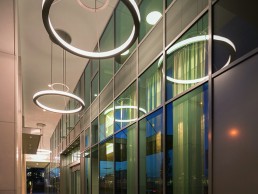
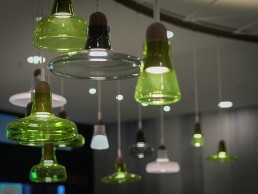
“As the main public guest functions take place in the open lobby space, which covers around 1,000sqm, lighting plays a significant role in highlighting the distinctive layout and in continuously highlighting the relevant areas throughout the day,” says Boehm.
“The lighting design follows the overall design concept, which is influenced by three major factors: the strong connection to the adjacent park with mature tree stock in the heart of Gateway Gardens; the geometric symbolism of Hyatt Place as part of the brand’s identity; and the local reference to Frankfurt and the Rhein Main area, combined with the global network passing through Frankfurt International Airport.
“The main goal of decorative lighting in the hotel welcome area with the reception and bar is to introduce and support the individual design concept for arriving guests. In terms of architectural lighting, in this case, it works to provide discreet and understated illumination, while the decorative lighting features are the focal points throughout the hotel.
“One of the major lighting features is a group of large suspended steel rings equipped with uplights, of which the largest is 8.5m in diameter. These huge parts required extra care in terms of planning and installation.
“Proceeding further throughout public spaces, lighting features were chosen to meet the needs of a flexible and multi-functional space and allow guests to dine, work and relax. In the rooms and bathrooms, lighting creates a comfortable living atmosphere and sense of well-being.”
As this property is the country’s first Hyatt Place, JOI-Design was given the task of originating a bedroom concept relevant for the German marketplace and typical guest profile. In a scenario where travellers usually stay for only one night, suitcases are rarely unpacked. The studio realised the conventional closet could be eliminated to free up floor space. Instead, a minimalist set-up with a luggage rack and golden pipes for hanging clothes creates an open, airy and urban feel. The typical massive writing desk has been replaced by a round, multifunctional table suitable for working or eating and the buly sofar has been swapped for a streamlined chaise longue where travellers can recline. JOI-Design’s philosophy when developing hospitality concepts is to embed subtle cultural references through interior details that together, add up to an impression of the locale.
“What you cannot achieve with furniture or any other design features can be delivered through lighting,” concludes Boehm. “It creates a dynamic change of atmosphere throughout the day.



